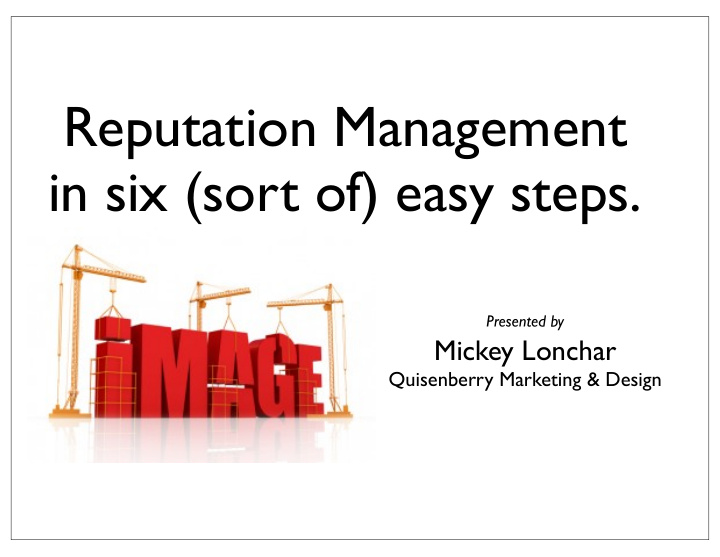



Reputation Management in six (sort of) easy steps. Presented by Mickey Lonchar Quisenberry Marketing & Design
“Your Permanent Record,” circa 1960’s:
“Your Permanent Record,” circa 2012: The “picture” people get about you is defined by how you show up in search results.
Your next resume: Google.
What people used to do after a bad experience:
What people now do after a bad experience:
What people now do after a bad experience:
What people now do after a bad experience:
What people now do after a bad experience:
What people now do after a bad experience:
Goals of Reputation Management?
Goals of Reputation Management? • Improve “sentiment” of comments.
Goals of Reputation Management? • Improve “sentiment” of comments. • Have the most-positive mentions rank higher.
Goals of Reputation Management? • Improve “sentiment” of comments. • Have the most-positive mentions rank higher. • Have more people spread your “positive” content.
1. Accept that knowledge is power. • “If I ignore it, maybe everyone else will too.” Not.
1. Accept that knowledge is power. • “If I ignore it, maybe everyone else will too.” Not. • Know what’s being said so you can address it.
1. Accept that knowledge is power.
1. Accept that knowledge is power.
2. Take steps to “organize the speech.”
2. Take steps to “organize the speech.” • Add fresh, interesting content on a regular basis.
2. Take steps to “organize the speech.” • Add fresh, interesting content on a regular basis. •Use tags and meta data.
2. Take steps to “organize the speech.” • Add fresh, interesting content on a regular basis. • Use tags and meta data. • Correctly “claim” the listings you’re entitled to.
2. Take steps to “organize the speech.”
2. Take steps to “organize the speech.”
2. Take steps to “organize the speech.”
2. Take steps to “organize the speech.”
3. Give visitors a place to talk about you.
3. Give visitors a place to talk about you. • Social Media (Facebook, Twitter, etc.)
3. Give visitors a place to talk about you. • Social Media (Facebook, Twitter, etc.) • Blogs
3. Give visitors a place to talk about you. • Social Media (Facebook, Twitter, etc.) • Blogs • Social Media buttons/ badges
3. Give visitors a place to talk about you.
3. Give visitors a place to talk about you.
3. Give visitors a place to talk about you.
3. Give visitors a place to talk about you.
4. Rationally respond to the not-so-good stuff.
4. Rationally respond to the not-so-good stuff. • Do it with an attitude of “helping.”
4. Rationally respond to the not-so-good stuff. • Do it with an attitude of “helping.” • Be transparent & sincere.
4. Rationally respond to the not-so-good stuff. • Do it with an attitude of “helping.” • Be transparent & sincere. • Migrate complaints off-line.
4. Rationally respond to the not-so-good stuff. • “One-on-one conversation in front of hundreds of people.”
5. Reach out to people & groups who love your brand.
5. Reach out to people & groups who love your brand. • Invite them to comment and share.
5. Reach out to people & groups who love your brand. • Invite them to comment and share. • Drive engagement with social apps.
5. Reach out to people & groups who love your brand. • Invite them to comment and share. • Drive engagement with social apps. • “Crowdsource” & co-create.
5. Reach out to people & groups who love your brand. • Turn frequent contributors into “advocates.”
6. Check Google results regular & routinely publish new content.
6. Check Google results regular & routinely publish new content. • Google indexes “pages” not web sites.
6. Check Google results regular & routinely publish new content. • Google indexes “pages” not web sites. • Use blogs to indirectly answer negative posts.
Reputation Management Bonuses:
Reputation Management Bonuses: • Learn more about your customers’ preferences.
Reputation Management Bonuses: • Learn more about your customers’ preferences. • Real-time feedback.
Reputation Management Bonuses: • Learn more about your customers’ preferences. • Real-time feedback. • Nurture customer loyalty.
Questions?
Contact info: mickey@quisenberry.net Blog: quisenblog.com Twitter: @mickeylonchar Request a pdf of this presentation at mickey@quisenberry.net
Recommend
More recommend